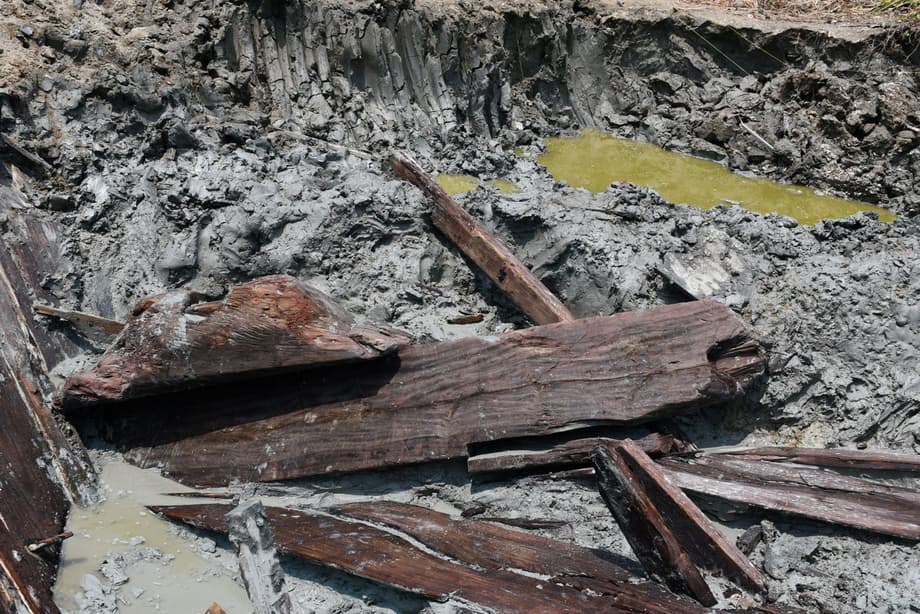A landmark find on Pulau Melaka
Archaeologists in Malaysia have uncovered the remains of a large wooden ship on Pulau Melaka, the island just off the historic port city of Melaka. The joint team from the National Heritage Department and the Melaka Museum Authority exposed multiple timbers that once formed a single hull, including sections of the bow and the lower structure. Early measurements suggest a vessel between 50 and 70 meters long (160 to 230 feet). Initial analysis of wood samples points to locally sourced materials and a working date in the 13th century.
- A landmark find on Pulau Melaka
- How big was the vessel and what was it made of
- Why the 13th century matters in the Strait of Malacca
- What the ship may reveal about Malay shipbuilding
- Excavation and conservation plan
- From site to museum, who is involved
- Tourism potential and site protection
- What researchers still need to confirm
- The Bottom Line
The discovery hints at the scale of seafaring in the Strait of Malacca well before the rise of the Malacca Sultanate around 1400. Traders from India, the Middle East and China used this passage to move ceramics, metals, textiles and spices. A ship of this size, built from local hardwoods, offers a rare chance to study how Malay shipwrights constructed ocean going vessels and how crews operated along one of Asia’s busiest maritime corridors.
Where and how the wreck emerged
Pulau Melaka sits near the mouth of the Melaka River, next to the historic urban core. The excavation forms part of a planned heritage investigation led by the National Heritage Department with the Melaka Museum Authority. Crews opened a grid, documented layers of soil and silt, and mapped each timber. Work proceeds slowly to prevent drying and cracking. Fresh finds are kept wet, tented from direct sun, and tagged for sampling and conservation.
How big was the vessel and what was it made of
Even by regional standards, a ship in the 50 to 70 meter range is a large craft. That scale suggests a deep hull capable of carrying heavy loads across long distances. Southeast Asian sources from later centuries describe towering wooden ships from the Malay and Javanese world, able to trade across the Bay of Bengal and the South China Sea. The Malacca find appears to be within that tradition of big timber ships.
Preliminary study points to saga wood, a species native to the Malay Archipelago, as the primary material. Researchers have also reported traces of merbau in some pieces. Both are hardwoods used in regional boatyards. Field notes mention fastenings that could include copper nails or wooden pegs, techniques that align with long running shipbuilding practices in maritime Southeast Asia. Laboratory analysis will confirm the wood species and the exact fastening system.
Length estimates come from the spread of surviving timbers and the curvature of the strakes, not from an intact keel. As more pieces are exposed, the range will tighten. The team will rely on combined measurements of plank runs, frame spacing and bow sweep to refine the estimate.
Why the 13th century matters in the Strait of Malacca
The 13th century was a turning point on the water. Seasonal monsoon winds let crews sail west with the northeast monsoon, then return east with the southwest monsoon. That rhythm linked ports from Gujarat and the Persian Gulf to the Pearl River Delta. Bulk cargo like ceramics, tin, pepper and textiles moved in predictable cycles, and transshipment hubs grew along the Malay Peninsula.
Historians place the decline of Srivijaya, the earlier maritime power based around Sumatra, in this period. New regional centers rose as trade intensified under the Song and Yuan dynasties in China. In that setting, a large Malay ship operating near Melaka would fit an age of open sea trade, coastal pilotage, and mixed cargo. Reports from the site mention coins and porcelain fragments found near the timbers, the kind of material often linked to trade contexts.
Dating a shipwreck is rarely simple. Specialists will look at radiocarbon results from the wood, the species mix, tool marks left by adzes and saws, and the style of any recovered ceramics or coins. Each data point carries its own margin of error. Combining them can narrow the window of time. The current working date in the 1200s gives the team a solid baseline for further testing. Some reports have floated an earlier age, around 1,200 to 1,300 years, which would push the ship into the early medieval period. The project team continues to cite the 13th century as the working date pending lab results.
What the ship may reveal about Malay shipbuilding
Very few large Malay ships survive in the archaeological record. Written accounts from the 14th and 15th centuries describe great jongs and other vessels with thick planking and multiple masts. Many used indigenous methods such as plank joining with wooden dowels and internal lugs, sometimes with minimal iron. The Pulau Melaka timbers may help document how builders combined local hardwoods, fastening systems and hull shapes at scale.
Construction details can answer practical questions. Plank thickness and frame spacing indicate how much weight the hull could carry. The angle of the bow and the rake of the stern suggest how the ship handled currents and surf. Tool marks reveal whether the yard used adze finished surfaces or saw cut planks. Every piece reduces guesswork about how a large Malay vessel was actually built, maintained and sailed.
Excavation and conservation plan
Excavating a waterlogged wooden wreck is a race against time and evaporation. The team must record the position of each plank and frame before movement changes the geometry. Standard practice is to keep timbers wet from exposure to storage, then move them to tanks for stabilization. Samples will go to specialized labs for species identification, radiocarbon dating and residue analysis. Photogrammetry and laser scanning can capture the shape in three dimensions for study and future reconstruction.
Conservators will likely treat the wood with polyethylene glycol, a waxy polymer that replaces water in the cell walls and prevents collapse as the timber dries. Large elements sometimes require years in PEG baths and controlled drying. A structural cradle can support heavy pieces during treatment. When stable, the parts can be displayed in a climate controlled gallery with gentle lighting and tight humidity control. The plan announced by the authorities is to extract the components, conserve them, and prepare them for public display once research is complete.
From site to museum, who is involved
The National Heritage Department leads the project with the Melaka Museum Authority. Local academic partners are expected to join the analysis phase, including specialists in wood anatomy, maritime archaeology and conservation science. The collaboration brings together field teams, museum curators and lab scientists who can handle delicate timbers, artifacts and environmental samples.
Melaka’s state leadership has signaled interest in displaying the ship after conservation, adding a major chapter to the state’s museum network. Any exhibition will require detailed interpretive work, including models of the original hull, maps of 13th century trading routes, and context about Malay seafaring. A public gallery would offer visitors a new way to grasp the scale of regional shipping at the time.
Tourism potential and site protection
A find of this scale can draw visitors and new investment in heritage education. Melaka is already a magnet for history seekers. A well documented shipwreck can anchor fresh programs for schools, scholars and tourists. Programming can include viewing windows into conservation labs, temporary exhibits on shipbuilding, and guided walks that connect the museum to the waterfront.
Care comes first. Waterlogged wood can deteriorate quickly if conditions change. The site needs security and a stable environment while excavation proceeds. Long term, the museum will need budget and trained staff to monitor the conserved timbers. Responsible access, clear signage and accurate storytelling help protect the artifacts while sharing them with the public.
What researchers still need to confirm
The discovery opens a set of technical and historical questions that the team will work through as the study advances.
- Precise date of construction and loss based on laboratory results and artifact study
- Ship type, rig configuration and likely home port or building center
- Nature of cargo, onboard supplies and crew equipment
- Fastening method, including the balance of dowels, pegs and metal
- Route and range, including links to ports across the Indian Ocean and South China Sea
- How the vessel came to rest at this spot, whether by grounding, storm damage or deliberate scuttling
- Ancient shoreline position and local geomorphology at the time of sinking
The Bottom Line
- Archaeologists found a large wooden shipwreck on Pulau Melaka during a joint excavation
- Length is estimated at 50 to 70 meters (160 to 230 feet)
- Initial work points to a 13th century date based on wood and context
- Timbers include saga wood with reported traces of merbau
- National Heritage Department and the Melaka Museum Authority lead the project
- Plan is to extract, conserve and study the components for later museum display
- The find highlights deep maritime roots in the Strait of Malacca
- Further testing will refine the date, construction details and the ship’s role in trade




